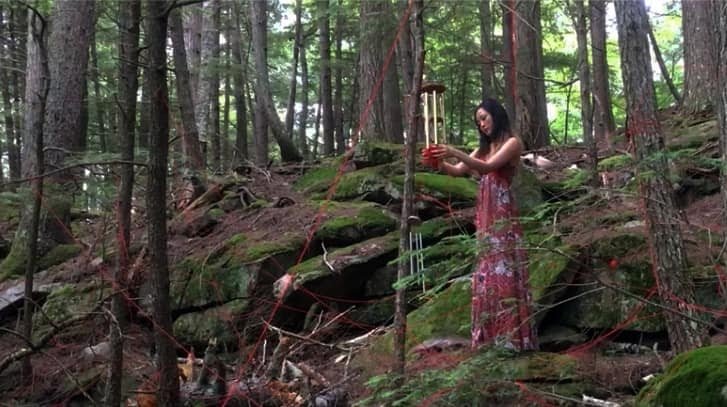
She Walks the Air I
a site-specific solo performance installation in slow tempo
Bearnstow, 2017
Photographed by Peter Kyle
I appropriated a line from one of the scenes in Ota Shogo’s The Water Station, “Woman in a Parasol” describing an older woman's movement across the stage to a water pump in extreme slowness. “She walks the air,” it wrote. I found the grammatical hiccup interesting. What the Japanese translation could have meant was not relevant. The hiccup to me felt like a smeared entry stamp on the passport. A signage that something has traveled a large distance, that is not easily compressible. It was a marker that there is something not transcendent, or permissible through the boundaries of time and space between the Japanese and English speaking world. I was eager to celebrate that, often living in the in between space of translations, and also poke fun at it. It was thrilling that it was a proof of why my labor of constant translation was an insurmountable task, and that I have proven in some pressuring logos-centric world that there are some meanings that do not quite transfer intactly. There is such a thing as cultural relativism. There is such an existence that falls through cracks.
“She walks the air” as a sentence was not only poetic, but filled with potential energy. It could mean “she walks in the air,” the way “a dog walks on the road,” while also “she walks the air,” the way “I walk the dog.” The interchangeability of subject and object was fascinating to me, especially because I was subconsciously trying to subvert some system of power. I thought of material that can visualize the air: wind chimes, and yarn. I created an image of a woman that is trapped in a trapping that she has made for herself. Looking back, the impulse to make this piece with my solo body, and to visualize the thickness of what is considered the void shows the intensity I wanted to spell out the existence of “Sick Women.”
By “Sick Women,” I am alluding to Johanna Hedva’s definition in their article “Sick Woman Theory,” "...an identity and body that can belong to anyone denied the privileged existence—or the cruelly optimistic promise of such an existence—of the white, straight, healthy, neurotypical, upper and middle-class, cis- and able-bodied man who makes his home in a wealthy country, has never not had health insurance, and whose importance to society is everywhere recognized and made explicit by that society; whose importance and care dominates that society, at the expense of everyone else."